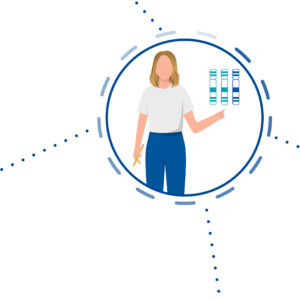With a prevalence of 1:3,000, neurofibromatosis type 1 (NF1, M. Recklinghausen) is one of the most common hereditary neurological disorders associated with benign and malignant tumors of the nervous system. Characteristic features include cutaneous and subcutaneous neurofibromas that typically occur in adolescence, café-au-lait spots of the skin that usually manifest in the first decade of life, freckle-like spots in the axilla or groin, and Lisch nodules of the iris. Less frequent are severe clinical manifestations such as plexifomous neurofibromas, optic gliomas, neurofibrosarcomas, and bone lesions. Diagnostic criteria for NF1 were developed by the National Institutes of Health (NIH) in 1988. NF1 shows complete penetrance with high phenotypic variability. The inheritance pattern is autosomal dominant, with 50% of patients having a positive family history, while 50% of cases are caused by new mutations.
The genetic cause of NF1 are pathogenic loss-of-function variants in the NF1 gene. The variants are distributed across almost all exons or adjacent intron sequences and include all mutation types, with translational stop mutations being the most common at 80%. 22-30% of nucleotide alterations affect splicing, 1/3 of which are undetectable using only DNA-based methods. At least 5% of patients have a type 1 (1.4 Mb), type 2 (1.2 Mb), type 3 (1.0 Mb), or atypical microdeletion in chromosome 17q11.2 involving the NF1 gene. These microdeletions, as well as intragenic deletions affecting one or more exons, account for approximately 2% of all variants in the NF1 gene. Duplications of the entire NF1 gene and flanking genomic region, unlike microdeletions, do not result in a characteristic NF1 phenotype. Affected patients may present with developmental delay and epilepsy. The mutation rate in the NF1 gene is one of the highest in the human genome at 1:10,000. A new mutation is present in half of the patients. The gene product of NF1, neurofibromin, functions as a tumor suppressor by controlling cellular proliferation through activation of a Ras-GTPase.
Pathogenic variants in the NF1 gene can be detected in more than 95% of patients who meet the diagnostic criteria of the NIH Consensus Development Conference Statement for neurofibromatosis type 1 (NF1) using a combination of several analytical techniques that include coding region sequence analysis, deletion/duplication analysis, and cDNA analysis. However, cDNA analyses are not part of routine diagnostics.
A differential diagnosis to NF1 is Legius syndrome. Patients with Legius syndrome also meet the NIH diagnostic criteria of NF1. A characteristic difference from NF1 is the absence of Lisch nodules of the iris and neurofibromas, and the presence of subcutaneous lipomas in adulthood. The molecular cause of Legius syndrome is heterozygous variants in the SPRED1 gene.
Constitutional mismatch repair deficiency syndrome (CMMRDS) represents another differential diagnosis in terms of skin manifestations. CMMRDS is a rare childhood tumor predisposition syndrome with clinically overlapping symptoms to NF1 such as cafe-au-lait spots, freckling, and Lisch nodules. The disease is characterized by the occurrence of various tumors such as brain tumors, gastrointestinal tract tumors, hematologic neoplasms, and rare tumors (e.g., sarcomas). The molecular cause of autosomal recessive CMMRDS is homozygous or combined heterozygous pathogenic variants in one of the four mismatch repair genes MLH1, MSH2, MSH6 or PMS2. An indicator of CMMRDS is the presence of clinical symptoms of Lynch syndrome in one or both parents.
Up to 10% of all pathogenic variants in the NF1 gene are present as somatic mosaics that can be detected by deep sequencing.
In familial tumor diseases, every genetic diagnosis should be accompanied by genetic counseling. In predictive diagnostics, genetic counseling must be provided before the examination and after the results are available (§10, Abs2 GenDG). According to the recommendations of the professional societies, psychotherapeutic care should be provided before, during and after the examination phase.
References
Friedman In: Pagon RA, Adam MP, Ardinger HH, et al, eds. GeneReviews® (Last Revision: June 6, 2019) / Kehrer-Sawatzki et al. 2017, Hum Genet 136:349 / Wimmer et al. 2017, Clin Genet 91:507 / Evans et al. 2016, EBioMedicine 7:212 / Pasmant et al. 2015, Eur J Hum Genet 23:596 / van Minkelen et al. 2014, Clin Genet 85:318 / Sabbagh et al. 2013, Hum Mutat 34:1510 / Vogt et al. 2012, Hum Mutat 33:1599 / Valero et al. 2011, J Mol Diagn 13:113 / Messiaen and Wimmer 2008, In: Kaufmann D, ed. Monographs in Human Genetics. Vol 16:63 / NIH Consensus Development Conference Statement: neurofibromatosis. Bethesda, Md., USA, July 13-15, 1987, Neurofibromatosis 1:172





















